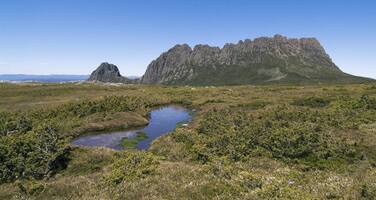Tasmanian Wilderness
Factors affecting the property in 2000*
- Forestry /wood production
- Ground transport infrastructure
Factors* affecting the property identified in previous reports
- Potential construction of a dam (issue resolved)
- Commercial logging in areas adjacent to the World Heritage property
- Roading activities adjacent to the site
International Assistance: requests for the property until 2000
Total amount approved : 0 USD
Missions to the property until 2000**
Information presented to the Bureau of the World Heritage Committee in 2000
Previous deliberations:
Twenty-third session of the Bureau -paragraph IV.48
Twenty-third session of the Committee - paragraph X.29 and Annex VIII
New information: At its twenty-third session (Marrakesh, November/December 1999), the Committee requested the Australian Committee for IUCN (ACIUCN) to complete its review process on the state of conservation of the Tasmanian Wilderness with the aim of submitting an up-to-date report to the twenty-fourth session of the Bureau in 2000.
IUCN has informed the Centre that, as with Shark Bay, ACIUCN has established a collaborative process to finalise a report on the state of conservation for the Tasmanian Wilderness. Subject to ACIUCN receiving adequate resources to carry out this assessment, the ACIUCN report will be submitted in 2001. It is anticipated that issues that will be addressed in the report will include management of areas of the Regional Forest Agreement (RFA) which are outside the World Heritage site but which have been previously identified as having World Heritage value, proposals to develop helicopter tourism with the World Heritage site and impacts associated with bushwalking.
In a letter from the World Heritage Branch of Environment Australia dated 6 April the Director of the Centre was informed that the Australian government is aware of the delay in the preparation of the ACIUCN report on the state of conservation of the Tasmanian Wilderness due to resourcing and time constraints. The Australian government will be working co-operatively with ACIUCN to finalise the report. It was recalled that in his letter dated 14 September 1999, the Minister for Environment and Heritage has indicated that at present, boundary extensions are not being actively considered.
Action Required
Summary of the interventions
Decisions adopted by the Committee in 2000
24 BUR IV.B.47
Tasmanian Wilderness (Australia)
The Bureau noted that as in the case of Shark Bay, ACIUCN has established a collaborative process to prepare a report on the state of conservation of this site. It noted the view expressed by IUCN that the process will be complete and a report submitted in 2001 subject to ACIUCN receiving adequate resources. The Bureau noted that the issues addressed will include the management of areas of the Regional Forest Agreement (RFA) which are outside of the World Heritage site but which have been previously identified as having World Heritage value, proposals to develop helicopter landing sites and impacts associated with bush walking.
The Bureau was informed that the Australian Government was aware of the delays in the preparation of the report by ACIUCN due to resource and time constraints. The Delegate of Australia informed the Bureau that his Government is working with ACIUCN to develop a systematic approach to monitoring this site that could be also linked to periodic reporting of World Heritage sites in the Asia Pacific to be submitted to the World Heritage Committee in the year 2002.
The Bureau, while recognising the resource and time constraints that ACIUCN is currently facing, requested ACIUCN to complete the process with the aim of submitting an up-to-date state of conservation report to the twenty-fifth ordinary session of the Bureau in 2001.
Exports
* :
The threats indicated are listed in alphabetical order; their order does not constitute a classification according to the importance of their impact on the property.
Furthermore, they are presented irrespective of the type of threat faced by the property, i.e. with specific and proven imminent danger (“ascertained danger”) or with threats which could have deleterious effects on the property’s Outstanding Universal Value (“potential danger”).
** : All mission reports are not always available electronically.


